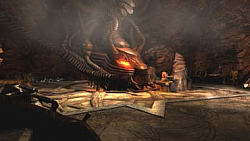Review of Ring II – Twilight of the Gods (European Version)
Ring II is the sequel to “Ring – The Legend of the Nibelungen” (Ring I),
an adventure game published in 1999 that was based on the first two operas
in Richard Wagner’s Cycle of the Ring. Ring I was wildly creative. It
also received the worst print magazine reviews of any adventure game I’ve
seen. It went on to sell more than 400,000 copies worldwide.
I’ve been anticipating this sequel for quite awhile. I longed once again
to wander through worlds infused with Philippe Druillet’s spectacular
graphical style; to sail through the starry night where ancient gods
fashion the destinies of men. I wanted to immerse myself in Wagner’s rich
music and to hobnob with muscle-bound heroes, fantastic creatures, winsome
heroines, and dastardly villains.
Ring II is loosely based on the last two operas in the Ring saga. The
game begins at the underground forge of Mime, the brother of Alberich,
King of the Dwarves. Mime has a young apprentice, merely a boy, who wears
a cumbersome metal cage. You direct the apprentice within this
contraption by using keyboard controls.
Mime hurls insults at his apprentice pretty much non-stop. Although this
is not the best way to invite the player into a game, it does make you
empathize with the poor apprentice who – as it turns out -- is Siegfried,
the last of the Walsungs. When the fetters finally fall from young
Siegfried, you breathe as large a sigh of relief as he does.
In the following chapters, Siegfried discovers his heritage and strives to
prove himself worthy of it. You guide the young hero through beautiful
meadows with fluttering butterflies, eerily-lit caverns and a forest edged
with gilded leaves. There is a magical innocence in these worlds but there
are also dangers: including huge spiders, wily dwarves, and a giant ogre.
It is impossible to complete the game without dying frequently.
Curiously, you don’t control Siegfried during the combat sequences, but
merely observe the battles through a series of cutscenes. The most
difficult gaming challenges pit our hero against aspects of his
environment. Siegfried uses his wits and/or reflexes to avoid being
crushed, stung, burnt, or metamorphized. Ring II’s “action” sequences for
the most part do not require very quick reflexes; however two sequences
late in the game may seriously strain your skill at the keyboard.
Wagner’s music adds tremendously to the enjoyment of this game. The
integration of the music is better in Ring II than in Ring I. More care
was clearly taken in Ring II to match the story-in-the-music with the
story unfolding onscreen. This time I didn’t have that “Why am I hearing
bombastic music while Alberich rides his motorcycle?” experience.
There are many cutscenes in Ring II, and they are beautifully done. The
dialogue is well-written and the voice acting is top-notch.
Late in the game Siegfried encounters an entirely different sort of
adventure with the most desirable woman in the universe. Sadly, the
romantic aspect of Siegfried’s character is poorly developed. I thought
that love might soften our innocent yet deadly-dangerous hero, but in Ring
II tenderness isn’t much of a part of Siegfried’s makeup. Events that
follow this episode are earth-shattering, but confusing. Suddenly the
gaming challenges end and a series of conversations take place that lead
to the final cutscene. Text passages in the Story section of the game
struggle poetically to explain what has just happened. Afterwards I
reread these texts several times in an attempt to fully understand the
ending. I did not succeed.
Since finishing Ring II, I have begun replaying Ring I. The truth is
that, in most respects, Ring II is the better game. The graphics, the
music, and the puzzle integration – all are superior in Ring II. The
storyline is easier to follow. Even the ending in Ring II is better than
the ending in Ring I (though this isn’t saying much).
Nevertheless, I liked Ring I better than its sequel. Ring I was
gloriously bizarre -- unlike any other game of its time. Though original
in its own right, Ring II falls short of Ring I’s ability to astonish and
amuse. There are many places in Ring II where a single misstep can bring
death, and these ultimately become more frustrating than entertaining.
Still, I think that the imaginative elements in Ring II give it the
potential, like Ring I, to become a one-of-a-kind classic.
Quick List for Ring II
Ring II contains one sliding tile puzzle, no sound-matching puzzles, no
math puzzles and no mazes. You die early, often, and bloodlessly, though
not noiselessly. Performance is occasionally time-sensitive. The game is
keyboard-driven, with mouse control for most of the puzzles. On a
keyboard expertise scale of 1 (novice) to 5 (expert), you will need a 2 to
get through most of the game, and a 4 to get through two challenges near
the end. The inventory holds one item at a time. Other inventory items
sparkle from their locations on the ground. Menus are easy to use.
Unlimited saves are allowed.
Visit the Configuration Menu before you start the game – the default setting
does not optimize the graphics and there are settings for specific video
cards that make a big difference. I encountered one bug which corrupted
previously saved games. Apparently this problem was caused by my
virus-checking software.
The Ring II lowdown: other-worldly graphics that combine gorgeous natural
landscapes with medieval and futuristic techno-creations. Outstanding
music, dialogue and dramatic voice-acting. Third-person perspective.
Classic but confusing plot, which is somewhat easier to follow if you’ve
already played Ring I. Puzzle difficulty (except the slider): easy.
Ring II is at heart a traditional adventure with the addition of some
keyboard-movement challenges. Aimed at gamers who crave beauty, fantasy
and novelty.
Final Grade: B+
copyright © 2004
GameBoomers
